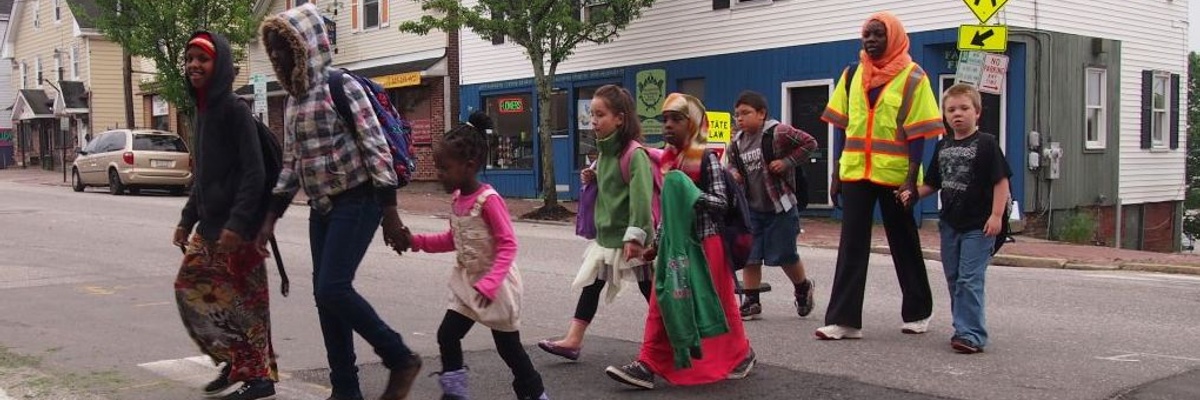
"Welcome to the Walking School Bus Guide! Here you’ll find all the information you need to set up a Walking School Bus in your area. Depending on the size of your community and the number of kids involved, it will be slightly different for everyone. We hope you enjoy giving the kids in your area a healthier and more fun way to get to school!" - National Center for Safe Routes to School

It will take 4/5 hours to initially set this up and then parents can take turns accompanying children to school each day.
As part of your 30 Day Challenge, the most important step is forming a team. The most successful Walking School Bus projects are a collaborative effort, plus, it's far more fun if you’ve got support and can share the workload! Find other interested people to help you. You will need a team of approximately 5 people. Assign different roles to each person, including managing volunteers and schedules, communicating with parents and schools and spreading the word in the community.
To get started, first determine what level of interest exists at your child’s school. Will you be setting up a program that reaches most children at the school or will you be joining with one other family on your block to take your kids and theirs each day?
To determine the scope, start by contacting folks who may want to get involved:
1. Parent and students – These are the folks at the core of a Walking School Bus. Recruit them informally through the school’s newsletter, creating flyers, or announcing the initiative at a PTA meeting.
2. Principal and other school administrators: Getting buy-in from the top can help build enthusiasm and get the word out. Schedule a meeting with the school principal or other administrator to keep them in the loop and ask their advice on who else to talk to.
3. Other community leaders: Are there people in your neighborhood who advocate for more stop lights or crosswalks? Who do you know that cares about walkable neighborhoods? Invite them in and ask them to help!
4. Local businesses: Getting a couple of local businesses to give coupons or free prizes can help kick-off your Walking School Bus in a fun way that gets students talking.
Keep in mind that the number of people interested will help determine the route or routes for the Walking School Bus(es).
When picking a route, answer these four questions:
1. Do you have room to walk?
2. Is it easy to cross the street?
3. Do drivers behave well?
4. Does the environment feel safe?
The Centers for Disease Control and Prevention recommend one adult for every six children. If children are age 10 or older, fewer adults may be needed. If children are ages 4 to 6, one adult per three children is recommended.
Walking School Buses work best if there’s a leader for each bus route. This helps centralize communication and gives parent volunteers someone to check in with or ask questions of. If possible, try to recruit a leader for each route. Each leader can then find volunteer “drivers” for the bus route they’re supporting.
Get route leaders together and explain how the initiative works. It’s helpful for them to know each other so they can support each other as questions arise. As the organizer, your role is to coordinate details: get names, addresses, email addresses, phone numbers and availability (which days? Morning or afternoon?) from each leader and ask them to get them from the volunteer drivers on their routes. Keeping all of this information in a google doc or other centralized location will be helpful to all involved. If possible, have each leader set up the rotation and assign drivers to routes. Remember that the Walking School Bus may grow over time, so if you start out only doing it once or twice a week, that’s ok!
Inform parents about the chosen route, the starting date and the bus timetable. The bus should run on a strict timetable and not wait at the bus stop for latecomers. Parents should ensure that they are waiting at the bus stop to drop off and pick up children on the way home unless permission has been given for them to travel home unsupervised.
Parents need to remember that they are responsible for their child’s safety on the way to and from the designated bus stops. Parents should be given bus user guidelines and consent forms. Parents should give written consent for children to use the bus and inform the school of their child’s usual travel pattern, i.e. the days they will be using the bus going to/from school. It is the responsibility of the parents to let the driver know of any changes to this pattern. Parents are signing to indicate that they are permitting their children to participate in the Walking School Bus and that they have talked with their children about the need to behave safely and follow any instructions given by adults in charge of the bus. A child who endangers themselves or who misbehaves may be reported to the parent. The parents of a child who continuously misbehaves will be asked to withdraw the child from the Walking School Bus.
Walking School Bus recommends that volunteers and participating children wear fluorescent vests with reflective strips when travelling to and from school. Many groups have fun making signs that drivers and students carry along the route.